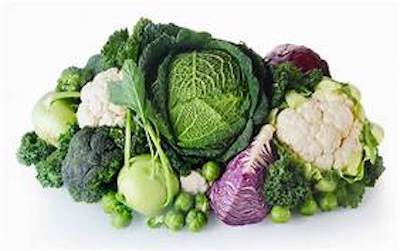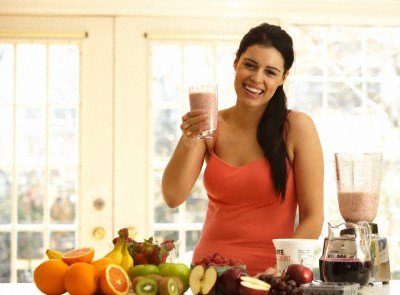Move To A Plant-based Diet With These 2 Food Groups

No diet is as healthy as a plant-based diet. This doesn’t mean you need to remove animal products from your diet entirely, but that you need to eat more plants, especially the cruciferous veggies and fibrous foods that improve immunity, blood sugar and fat metabolism, as well as reducing chronic inflammation, a hallmark of aging.
 (Is their plant-based diet making this couple happy, or are they grimacing?)
(Is their plant-based diet making this couple happy, or are they grimacing?)
If you’re like me during this stay-at-home COVID-19 crisis, you’ve become bi-polar, in that you are either:
- Alternating between wanting to make some productive use of this downtime, or
- Are distracted by the potential for infection, an economy in free fall, and an uncertain, fearful future.
In this post, I want to urge you to focus on number 1 — using this time to add something worthwhile to your life; perhaps something you’ve wanted to do, but didn’t have the time before now. And maybe it could be a plant-based diet.
A Plant-based Diet Is An Immune Enhancer
Certainly, there’s plenty of good stuff you could practice becoming good at.
Most of the 700+ articles I’ve written on this website are about the 12 things valuable to living a long and strong life, which distills down to extending your healthspan — those years you’re healthy.
The idea is to be able to spend your 80s and beyond free of debilitating physical, mental and emotional constraints. The science on this asserts that specific lifestyle changes can make this happen, even if you implement them late in life. Exercise, food, fasting, mindset and sleep all have important and synergistic roles to play to keep you healthy as you age.
Few things are as important to your life than a healthy life, something now strongly evident in the age of COVID-19.
A few weeks ago, I wrote about how you could spend this downtime to boost your immune system, and last week I wrote about using this time to get efficient at exercising at home by doing workout routines that last as little as four minutes.
Now, in this post, I want to turn to food. Even though some grocery stores can now be sparse in their food selections, and it’s more of a hassle to shop than before COVID-19 happened, this is still a golden opportunity to learn to eat better.
One of my favorite health columnists, Jane E. Brody, recently penned an article about using this shelter-in-place time to develop better food habits. Her focus was on children’s diets, but there are lessons pertinent for us well beyond childhood.
Citing some small improvements in American’s diets since 1999, she reports the findings of a recent Tufts University study that aren’t so sanguine:
“But there’s been little progress in curbing unwholesome consumption of processed meats, refined grains and salt and in increasing consumption of health-promoting vegetables, fish and shellfish and plant-based protein. The average daily intake of fruits and vegetables is now a mere 1.8 servings, not the four or five servings recommended, the study showed.”
Ms. Brody ends her article quoting Dr. Dariush Mozaffarian, one of the study’s authors, who told her:
In this time of crisis, healthy eating is more important than ever. Healthy foods can boost the immune system and help people of all ages fight off respiratory infections.
These days, boosting your immune system is highly recommended, and there’s good science to support the ability of a plant-based diet to do just that.
A Plant-base Diet — The Science
I just visited PubMed, the NIH research database, searched for “plant based diet” and scrolled down the first 20 of the 8,711 results, and didn’t find one study that did not extol the virtues of plant food.
Pathologist and Associate Professor Dan Winer from the Buck Institute for Research on Aging wouldn’t be surprised. An article on the Institute’s website about his research delved into the importance of a plant-based diet for the health of your gut, immune system, blood sugar and chronic inflammation, a key driver of age-related chronic disease.
Professor Winer said:
“The wall of the gut houses the largest collection of the cells that make up the immune system, a fact that comes as a surprise to most people. While conditions such as inflammatory bowel disease are directly linked to immune responses in the gut, most people don’t understand how important the gut is to overall health. The immune system in the gut traffics throughout the body. If your gut is chronically inflamed, you’re asking for all kinds of health problems.”
Tackling gut inflammation is where the veggies come in – especially cruciferous veggies such as broccoli, cauliflower, Brussels sprouts and cabbage. The essential focus of your diet should be, he explains, is to:
- Avoid processed foods, sugar and saturated fat, and
- To eat foods that can improve gut integrity and overall health.
Consuming cruciferous vegetables goes a long way to making you healthy, as you’ll soon learn.
Cruciferous Veggies Does A Body Good
Common cruciferous veggies include broccoli, cauliflower, Brussels sprouts and cabbage. These plants are high in sulforaphane, an antioxidant that acts as an anti-inflammatory in the gut. Dr. Winer says the compound shows promise in preventing a variety of cancers, and is also being studied for its effects against cardiovascular and neurodegenerative diseases and type 2 diabetes.
Moreover, eating cruciferous veggies activates a protein that regulates gene expression that helps maintain normal intestinal immune function and promotes the creation of interleukin-22, a compound that protects the gut, including preventing “leaky gut”.
Leaky gut is a condition that can happen when the junctions between cells lining the gut become weak and permeable, allowing bacteria, their products, and food particles to get into the bloodstream. When this happens, so does systemic (chronic) inflammation.
Part of how interleukin-22 protects the gut is by controlling harmful gut bacteria, thereby enabling beneficial gut bacteria to become more diversified and dominate the gut’s microbiota population. Our microbiome plays a huge role in helping to protect our body’s capacity to tolerate toxins and avoid food allergies.
(Read How The Right Gut Bacteria Benefits Your Health and Longevity)
Eat Fiber for Gut Health
Fiber helps modulate the immune system in the gut. Here’s how fiber does this:
- Undigested fiber is broken down by the bacteria in the gut into short-chain fatty acids which are a food source for the intestine itself.
- Cells that line the gut use the short-chain fatty acids from the fiber for energy. For instance, T-cells, one of the main immune cells in the gut, use those short-chain fatty acids to create Interleukin-10, an important anti-inflammatory which also helps prevent leaky gut.
Click here for a list of foods rich in fiber
According to Healthline, these 22 foods are rich in fiber:
1. Chia Seeds (34.4%). Fiber content: 10.6 grams per ounce of dried chia seeds, or 34.4 grams per 100 grams. Most nuts and seeds contain significant amounts of fiber. Examples include coconuts (9%), pistachios (10%), walnuts (7%), sunflower seeds (8.6%) and pumpkin seeds (18.4%).
2. Popcorn (14.5%). Fiber content: 1.2 grams per cup of air-popped popcorn, or 14.5 grams per 100 grams.
3. Almonds (12.5%). Fiber content: 3.4 grams per ounce, or 12.5 grams per 100 grams. Other nuts: Pistachios (10%), walnuts (7%), sunflower seeds (8.6%) and pumpkin seeds (18.4%).
4. Dark Chocolate (10.9%). Fiber content: 3.1 grams in a 1-ounce piece, or 10.9 grams per 100 grams.
5. Oats (10.6%). Fiber content: 16.5 grams per cup of raw oats, or 10.6 grams per 100 grams.
6. Artichoke (8.6%). Fiber content: 10.3 grams in one artichoke, or 8.6 grams per 100 grams.
7. Split Peas (8.3%). Fiber content: 16.3 grams per cup of cooked split peas, or 8.3 per 100 grams.
8. Lentils (7.9%). Fiber content: 15.6 grams per cup of cooked lentils, or 7.9 per 100 grams.
9. Chickpeas (7.6%). Fiber content: 12.5 grams per cup of cooked chickpeas, or 7.6 per 100 grams. Other High-Fiber Legumes: black beans (8.7%), edamame (5.2%), lima beans (5.3%) and baked beans (5.5%).
10. Kidney Beans (6.4%). Fiber content: 11.3 grams per cup of cooked beans, or 6.4 per 100 grams.
11. Avocado (6.7%). Fiber content: 10 grams in a cup, or 6.7 grams per 100 grams.
12. Raspberries (6.5%). Fiber content: One cup contains 8 grams of fiber, or 6.5 grams per 100 grams.
13. Pears (3.1%). Fiber content: 5.5 grams in a medium-sized pear, or 3.1 grams per 100 grams.
14. Quinoa (2.8%). Fiber content: 5.2 grams per cup of cooked quinoa, or 2.8 per 100 grams.
15. Carrots (2.8%). Fiber content: 3.6 grams in one cup, or 2.8 grams per 100 grams. This is very high given their low calorie content.
16. Beets (2.8%). Fiber content: 3.8 grams per cup, or 2.8 grams per 100 grams.
17. Broccoli (2.6%). Fiber content: 2.4 grams per cup, or 2.6 grams per 100 grams.
18. Bananas (2.6%). Fiber content: 3.1 grams in a medium-sized banana, or 2.6 grams per 100 grams. Also Blueberries (2.4%) and blackberries (5.3%).
19. Brussels Sprouts (2.6%). Fiber content: 4 grams per cup, or 2.6 grams per 100 grams. Almost all vegetables contain significant amounts of fiber. Other notable examples include kale (3.6%), spinach (2.2%) and tomatoes (1.2%).
20. Sweet Potatoes (2.5%). Fiber content: A medium-sized boiled sweet potato (without skin) has 3.8 grams of fiber, or 2.5 grams per 100 grams.
21. Apples (2.4%). Fiber content: 4.4 grams in a medium-sized apple, or 2.4 grams per 100 grams.
22. Strawberries (2%). Fiber content: 3 grams in one cup, or 2 grams per 100 grams. This is very high given their low calorie content.
So, just don’t add cruciferous vegetables to your plan-based diet, but also focus on consuming more vegetables and fruit that contain lots of fiber, such as:
- Chia Seeds (34.4% fiber)
- Almonds (12.5%)
- Dark Chocolate (10.9%)
- Oats (10.6%)
- Split Peas (8.3%)
- Lentils (7.9%)
- Avocado (6.7%)
- Raspberries (6.5%)
The 10+ trillion tiny microorganisms living in our intestines that make up most of our microbiome feed off fiber. The bacteria beneficial to our health increase in number and species diversity when we eat a fiber-rich, plant-based diet.
The more beneficial microbes we have in our intestines, the thicker the mucus wall and the better the barrier between our body and our busy bacterial population. That stronger barrier provides a two-for-one benefit: while the mucus barrier lowers inflammation throughout the body, the bacteria aid in digestion.
According to the Academy of Nutrition and Dietetics:
- Women should intake 25 grams of fiber per day, or 21 grams if over 50 years old.
- Men should intake 38 grams, or 30 grams if over 50.
Dr. Winer suggests that you:
- Add fiber to your plant-based diet slowly to avoid digestive distress, gas and intestinal blockages.
- Don’t think that consuming extra fiber justifies eating poorly; for instance, fiber and saturated fat are not a good combination. Fiber makes the high fat hang around in the colon encouraging bad bacteria to grow.
The immune System, Blood Sugar and Fat
Remember that protein I mentioned that regulates gene expression in a way that supports immunity? It’s called AhR (aryl hydrocarbon receptor), and by upregulating immunity in the gut, it helps control blood sugar and fat metabolism.
Dr. Winer says that excessive visceral fat can lead to insulin resistance and metabolic disease, which is why obesity is a major risk factor for type 2 diabetes. What happens here is that when there’s too much of it, visceral fat sends out inflammatory factors, which attract immune cells to promote insulin resistance inside the fat. And a leaky gut makes it worse by helping fuel the inflammatory processes in fat:
“Obesity sets off a cascade of inflammatory events which make it harder for the body to use natural insulin. It’s not the only factor at play with type 2 diabetes, but it’s important,” says Winer.
What we’ve learned then from Dr. Winer is that consuming more cruciferous vegetables and fiber will help improve your health by increasing your immunity, controlling blood sugar and fat metabolism. Hopefully, that should provide some motivation, which you can take to the next part of this piece about simple ways to get more plants into your diet.
Eat More Plants — Here’s How
I have gradually been consuming more plant foods for several years now. The science in support of a plant-based diet has moved me in this direction.
In my article, Eat Like A Gorilla — Your Scientifically Proven Best Diet, I went a bit broader in describing the health benefits attributable to a plant-based diet than did Dr. Winer above; I said eating plants can help you:
- Lose weight,
- Prevent and treat diabetes and heart disease,
- Lower blood pressure, and
- Live longer.
This doesn’t mean you have to become a vegetarian or vegan to get these benefits, but that the ratio of animal to plant foods needs to move in the direction of more plants, less meat, dairy and processed foods.
And, I submit to you, dear reader, that now is a good time to experiment with eating more veggies and fruit. After all, when will you have this much downtime again?
Smoothies
Fastest and most effective way to add veggies to your plant-based diet is to put them in smoothies. You will need to experiment with a recipe that will win you over, but I suggest that if heretofore you’ve purposely avoided vegetables, add them to your smoothies bit by bit.
At first, try spinach and peas, given that they’re both pretty benign in terms of taste once in a smoothie, assuming you add common delectables such as cinnamon (good for blood sugar), any of a number of types of plant protein powder (hemp, pea, brown rice, et al — good for muscle), berries (antioxidants and phytonutrients), chia seeds (fiber and omega-3 fatty acid — soak them overnight first), and almond milk (non-dairy substitute for milk).
Joe’s Smoothie Recipe (quantities according to personal preference):
- Frozen spinach (provides a consistent supply)
- Whatever cruciferous veggie is at hand (freeze them too)
- Soaked chia seeds
- Pea or hemp protein (or whey protein if after a workout because it’s assimilated faster)
- Blueberries (or combination of berries)
- Cinnamon
- Spirulina
- Mushroom powder (typically Turkey Tail mushroom)
- Almond milk
The next step in your move to build a plant-based diet is to actually learn how to make some scrumptious plant meals.
Your Veggie Meal Videos Kickstart
Ryan Sadilek has an interesting video entitled Eating A Whole Food Plant Based Diet ON LOCKDOWN. As I’ve been saying, now is a good time to pursue some good habits that you didn’t have time to make happen till now.
His video provides a couple of simple plant-based meals he’s eating during social distancing, and demonstrates a few simple, effective exercises you can do at home as well:
For the more ambitious of you, watch this video on how to prepare a meal consisting of roasted cauliflower, broccoli and Brussel sprouts — yes, your cruciferous trifecta!
Want more plant food ideas?
Check out a veggie dip here, and ten easy plant-based recipes with fewer than ten ingredients here.
Finally, there’s Prolon.
Is ProLon the Healthiest Meal Plan On the Planet?
It might be, but it’s not designed to be eaten regularly, but only during one week per month, and just two or three months each year, unless you have some chronic disease you seek to obliterate.
ProLon is the brainchild of Dr. Valter Longo, among the most heralded biogerontologist and cell biologist on the planet. He’s known for his studies on the role of fasting and nutrient response genes on cellular protection aging and diseases, as well as for proposing that longevity is regulated by similar genes and mechanisms in many species, such as humans.
I’ve written about the meal plan, ProLon, that Dr. Longo created: The ProLon Fasting Mimicking Diet — Get Better, Not Older. The gist of it is that:
The ProLon FMD is the only meal program that has gone through clinical trials. It’s also been patented for its anti-aging effects!
The ProLon meal plan is followed five days per month. You can go back to your normal diet (preferably plant-based) for the remaining 25 days of the month. This fasting-with-food meal plan is low in carbohydrates and proteins and has healthy fatty acids. The FMD patented recipe allows your body to stay under a fasting-like mode, which triggers a set of protection measures that the body has developed during natural selection when during times when food was scarce and not easy to find and store.
I mention ProLon in case you’re looking for a way to kick-start some new, better eating habits, or if you’ve been having some long-standing chronic issues that may have been ignited by a poor diet.
Your Takeaway On Plant-based Diet Essentials
If you’re reading this during the second quarter of 2020, you’re most likely housebound due to COVID-19. You may be filled with angst, understandably. But this is a good time to do something good for yourself, and doing so will go a long way to improving your outlook for the future.
Improving your diet would be worthy of your effort. Reach out to someone who cares about you and ask for his or her support, and to join you in adding plants to your diet, particularly cruciferous plants, as well as foods rich in fiber.
Use this time wisely, and emerge from this difficult time better than before.
Stay safe!
Last Updated on July 7, 2023 by Joe Garma







